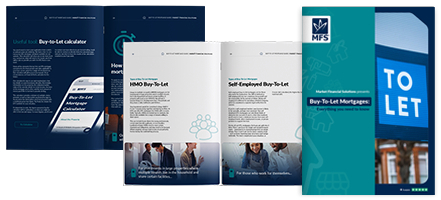
Written by Omkar Hushing
Deputy Chief Mortgage & Operations Officer – Front End
Market Financial Solutions are a bridging loan and buy-to-let mortgage provider and are not legal, financial, investment or tax advisers. This document is for informational purposes only and does not, and should not be considered, to constitute legal, financial, investment or tax advice or be relied upon by any person to make a legal, financial, investment or tax decision. Therefore, Investors are encouraged to seek appropriate professional advice. The information in this content is correct at time of writing.

Affordability is a difficult obstacle to overcome. Following September 2022’s mini-Budget, lenders tightened their criteria and increased rates. What’s more, this has hit homeowners and buy-to-let (BTL) investors alike.
Rising costs, along with rigid stress tests and lender hesitancy, dramatically cut how much people could borrow. Imagine taking out a fixed rate 5 years ago and finding the rate has now increased by 4%. What a lender decided was affordable back then may well not be now. A landlord may struggle to even raise enough to repay the existing mortgage. In fact, in the months after the mini-Budget, one in three landlords struggled to remortgage after failing their lender’s affordability test.
Given these difficulties, top-slicing mortgage solutions may become more prevalent in the market. But what exactly is top-slicing, and how are landlords affected by it? To help you get up to speed, we spoke with Mike Cook, Chief Mortgage Officer at Market Financial Solutions to answer those questions and more.
Source: This is Money, This is Money, Mortgage Solutions
What is a top-slicing mortgage?
In simple terms, a top-slicing mortgage is where a lender factors in a borrower’s surplus personal income to top up any shortfall in the rent needed to secure the loan. Where a property’s rental income doesn’t sufficiently cover the BTL mortgage interest payments, top-slicing can provide a solution.
Top-slicing mortgages may be more prevalent in parts of the UK where property costs are high. London, for example, has high property costs but the rental yield (or return) is often lower than other parts of the country. The costs of investing here may warrant top-slicing to show your surplus income can make up any shortfall.
It’s a great way to say “I know rent doesn’t necessarily meet 140% of the monthly interest, but I have enough surplus income from salary or my portfolio to help cover costs such as voids, maintenance or agency fees”. This gives a lender comfort outside of a strict maths formula.
Source: Mortgages for Business, This is Money
How does top-slicing work?
Lenders will have different approaches to a top-slicing mortgage. Most don’t offer them at all, while others may only allow them under very strict criteria. Generally, lenders will look at a borrower’s outgoings, and calculate how much surplus they’ll need to cover any rental shortfall and consider this a ‘top slice’ of income.
Often, this will require the borrower to be able to afford a sum greater than the monthly rent alone would generate. Typically for a high rate taxpayer the rent must cover the highest monthly interest cost you can afford by circa 145%. At Market Financial Solutions, we assess affordability through a broad spectrum.

How is affordability assessed?
Market Financial Solutions looks at a BTL case in its entirety. We assess not only rental income, but also overall assets and liabilities, accessible wealth, and surplus income levels. All this ensures you’ll be able to cover repayments along with other costs such as agency fees, voids, maintenance, tax, etc.
To explain how Market Financial Solutions utilises top-slicing buy-to-let, Mike Cook takes over: “Market Financial Solutions first calculates the maximum affordable interest payment based on the rent. Let’s say the landlord is still short on what they need to borrow, e.g. rent is only reaching 110% of the interest, but they need 130% to meet affordability criteria. If the landlord had plenty of surplus income, we can ‘increase the rent’ by up to 20% from their own means. It gives us comfort that the landlord can truly afford the loan from means other than rent. Otherwise, they may not be able to obtain the loan amount they require based on rent alone.
“We would review their earnings from other properties, surplus salary income, or significant savings/investments etc to see if they could ‘afford’ to top up the rent to cover the mortgage and other costs. Such as letting agent fees, maintenance, and voids.
“This wouldn’t pass with most lenders who would need at least 120%-130% just from the rent”.
In addition to top-slicing, we have several tools to calculate and boost the interest cover ratio (ICR) for your deal. As Mike added: “We can combine top-slicing with rolled or deferred interest to really boost the offered loan size. Ideal for Southeast England where rents may be low compared to the cost of the property. Reducing the interest you are due to pay during the loan (payable when you redeem) makes rent go further and so you can borrow more.”
How does top-slicing look in the real world?
To illustrate how this would work in practice: Say a borrower turns to us for capital to purchase a BTL asset. The landlord could put their own funds towards the purchase, but are short £150,000. This could be due to them awaiting the sale of another property which hasn’t completed yet.
To support the deal, we could review the client’s financials – exploring how much income they generate, and from where. Say they generate £8,000 a month from their business operations, while their expenses amount to £5,000. This leaves £3,000 in disposable income, which would likely allow comfort for Market Financial Solutions to take this ‘top slice’ of income to support a larger loan.
Why should you consider top-slicing and what are the benefits?
Top-slicing mortgages can be particularly useful for Buy-to-Let owners. It can help landlords facing rising costs and other pressures to gain access to the market. Meanwhile, their tenants may be less likely to face excessive rental hikes.
Mike elaborates: “You don’t ‘pay the top-slice’ to the lender – the lender just gets comfort that you can cover the mortgage interest and these extra costs.
“It’s great in the current market where affordability is making it difficult for investors to get the loan they need.”
But, while a top-slicing mortgage can support your BTL investment plans, there may be limited optionality among mainstream lenders. Indeed, in mid-2022, just as costs and rates started to skyrocket, some brokers noted lenders were underutilising top-slicing as a solution.
Even in the current market, top-slicing is considered a fairly niche option. Only a small number of lenders are willing to embrace it. Those that do, may only accept the most basic of cases. For example, some lenders may not offer it to first-time landlords, or to those investing in new builds.
Fortunately, we don’t have any of these limits in place. Every single case is assessed on its individual merit. What’s important to us is the value of the security, its long-term potential, and the exit strategy at hand.
So long as it makes sense within the context of your plans, we can offer top-slicing on all property types we lend on. This includes any residential property in mainland England or Wales.
Our buy-to-let top-slicing mortgage can be used for new builds, HMOs, student lets, MUFBs up to 30 units, holiday-lets and more. Regardless of the affordability issues you think will hold your plans back, we’ll do everything we can to find a solution. We look for reasons to lend, as opposed to finding excuses not to.
Source: The Mortgage Bureau, Mortgage Solutions, Online Mortgage Advisor
The Complete Guide to
Buy-to-Let Mortgages
Everything you need to know
- Fundamentals
- Different mortgage types
- Useful tools
- Industry stats & more





